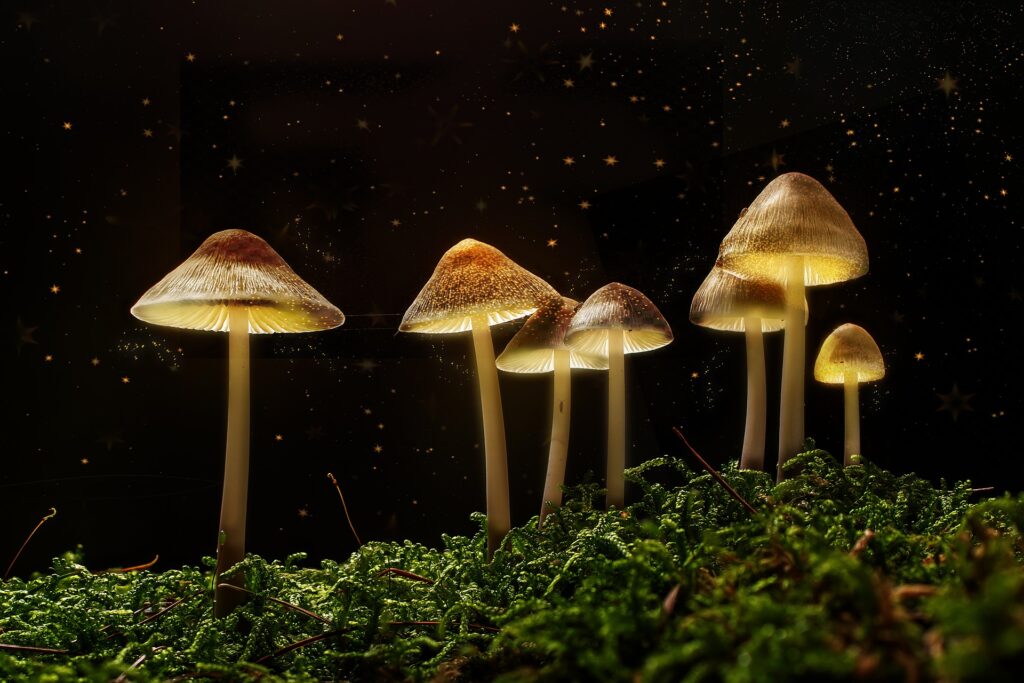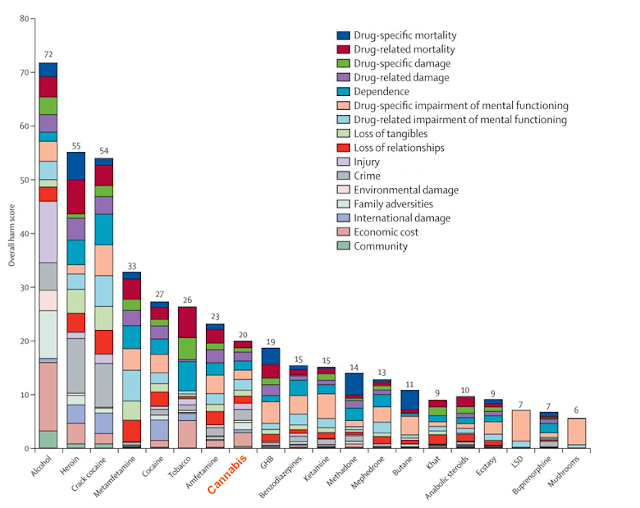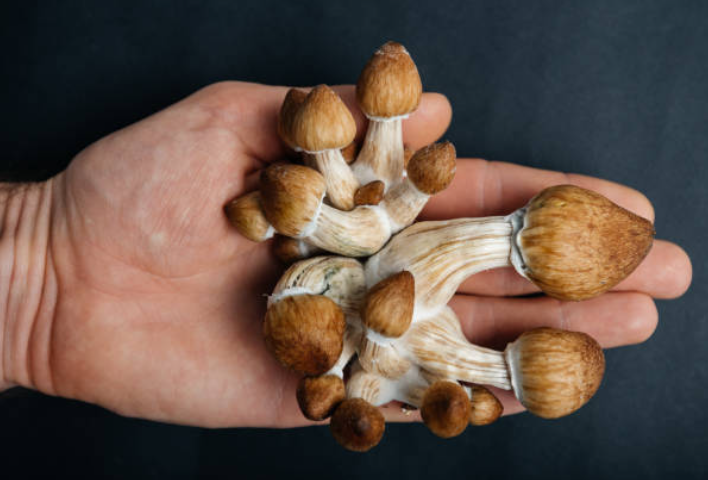
The use of those mind-altering mushrooms dates back several thousands of years. Suggested to have influenced our development as intelligent human being from mere apes, those mushrooms cannot only change apes to humans, but also aid a multitude of patients in alleviating mental and physical illnesses, as modern research proposes.
What is Psilocybin?
Psilocybin is the main psychoactive compound found in magic mushrooms. The compound is chemically considered a tryptamine and closely related to N,N-Dimethyltrypatmine (DMT). As such, the substance shows high similarities to serotonin and fits neatly in the serotonin-receptor type 5-HT2A. The mushrooms often turn blue when touching them, which is believed to be the Psilocybin converting into Psilocin, the actual effect-producing substance. The effects of Psilocybin (or Psilocin) are manifold, including altered states of consciousness, bringing deeply personal and sometimes unprocessed emotions and feelings to the forefront. Users often report a sense of oneness with everything and the universe. Others report a child-like state or heightened awareness with visual, and to a lesser extent auditory, hallucinations and altered perception of the self and surrounding. Spiritually, users often report to gain access to ones ‘higher self’ which could potentially present oneself as a guiding teacher in one’s life, confronting one with bad life-decisions and how to correct them. Thus, the most popular strain of Psilocybe cubensis is named ‘Golden Teacher’.
Some facts about Magic Mushrooms
- Magic Mushrooms exist way longer than humans do
- There are over 180 species containing psilocybin, distributed all over the world
- Psilocybin converts to Psilocin in the body and when oxidating (typical blue color)
- Psilocin is 100% water soluable and is not further metabolised by the body
- It is excreted via urine without any complications and further effort from the body
- It is believed that magic mushrooms produce psilocybin to deprive hunger of potential mushroom preditors, such as ants and insects.
- It was found that Magic Mushrooms contain, next to Psilocybin, multiple psychoactive substances (i.e. Baeocystin, Norpsilocin) including Monoamino-oxidase inhibitors (MAOI, such as Harmine) which intensify and prolong the effects of its other compounds synergistically.
- Paul Stamets, a leading mycologist and expert in the field, found that using small doses of magic mushrooms in combination with Niacin (Vitamin B3) and Lions Mane Mushroom promotes neuronal regrowth in the human brain and body.
- There is no documented case of mental or physical addiction to Magic Mushrooms. They are simply non-addictive.
- Magic Mushrooms were used in many cultures for ceremonial, healing and shamanic purposes (most famously among ancient mesoputan volks (Mayan, Aztecs, Mazatecs…)
Are those Mushrooms Toxic?
When it comes to drugs, we often seem to be biased towards negativity and horrific consequences of its uses. Moreover, depending on which culture someone is raised in, mushrooms are generally seen as potentially toxic and harmful (Mycophobe cultures), or useful and edible (Mycophile). In fact though, Magic Mushrooms are considered one of the most potent and impactful, while being the least toxic psychotropic drug available to humankind.
Research by David Nutt, Leslie King and Lawrence Phillips (2010) documented the toxicity and consequences for the self and others of several drugs in the UK. Their results speak for themselves, with magic mushrooms occupying the lowest score:

Legal Status
As seen, magic mushrooms are compared to many other psychoactive substances a rather safe bet. Paradoxically then, the use and possession of magic mushrooms is in most countries still highly prohibited, though slowly debated. During the last decade, a wave of decriminalisation has been crawling throughout the US. Some cities within Denver, Colorado, Michigan, Oregon and most recently, California decriminalised the use of the mushrooms. Oregon even went one step further and legalised its usage for therapeutic purposes.
Other parts of the world, such as our European countries, lack severely behind this wave of decriminalisation. Countries like Czechia, Italy, the Netherlands, Spain and Portugal have ambiguous regulations concerning the use and possession. Yet, none of them dared to make a first move towards clarity in legality.
However, with rapidly increasing research projects and scholars being more and more interested in the mystic experience those mushrooms provide (see for instance MAPS), the legality for recreational and medicinal use might be a question of time, not of ‘yes’ or ‘no’.
Therapy with Psilocybin-Mushrooms
Up to 2023, only a handful of institutions and health-practitioners offer therapy sessions which entail the use of magic mushrooms (mostly due to legal constraints and under-education). Those who do provide it, however, observed unbelievable results in the progress of their clients. From suddenly stopping decade-long alcohol and tobacco addictions to successful End-of-Life guidance in death-fearing cancer patients, the therapeutic potential of magic mushrooms is just as its experience itself: Simply Magical.
The reasoning behind the use of magic mushrooms in therapy is that they have the capability to get people into heightened states of consciousness, which potentially turn off perseverant habits, old and thinking patterns and rigid views on life. Furthermore, they are able to let us see ourselves, our life, our past decisions in a kind of outer perspective, which can eliminate our biases and prejudices. Basically, they can achieve in 8 hours what therapists can merely achieve in sometimes year-long therapy sessions. In a correct set and setting (being mentally and physically prepared while having a guiding expert), those mushrooms allow us to go into deep trance-like states and re-evaluate our life from the perspective of a past-independent self.
Lastly, it is through those enhanced states of consciousness and outer perspective on one’s life, which facilitates the resolution of deep, inner emotional and spiritual issues, potentially breaking through old habits and thinking patterns once and for all. By this mechanism, people can have unbelievable insights and draw value for them and their life within just one session, taking up to 8h of intensive self-reflection and spiritual conflict-resolution in an emotional up and down.
While some people encounter their deepest inner fears which they face on the experience, others may relive a traumatic situation while even others report to have the most meaningful time of their life. Such a high-intensity experience is therefore not suited for everybody, including people with genetic predispositions for schizophrenic disorders, or arguably very sensible and fearful characters.
An often reported fear is the fear of a bad trip, sometimes called “horror-trip”. What those reports mean is the experience of high anxiety, uncontrollable and victim-like states. From a therapeutic perspective, those states (when managed professionally) bring the most value to a client, though. This is, since the nature of those mushroom-experiences is to present us with our single most urgent topics we have to face. If we are not prepared for this, and are uncertain how to process and manage those situations, we might fall into a panic-state, which could (without guidance), result in a traumatic, horrific experience. Hence, people call those experiences horror-trip.
Nonetheless, the actual therapist is neither the mushroom, nor the guiding expert. It is actually one self, who is able to finally see things clearly and change ones own life to the better.
Associated Risks with Magic Mushrooms
Certainly, no medicine exists without having associated risks. With Magic Mushrooms, the most-often debated risk is the risk of psychosis, either drug-induced (psychosis can last up to 4 weeks) or genetically triggered by drugs (can last for several months and seldom a life-time in few people with genetic disposition for Schizophrenic disorders). Moreover, when already experiencing symptoms of psychosis, magic mushrooms could do both, worsen or alleviate the psychosis. Thus, a main associated risk with magic mushrooms is the risk of psychosis. This risk, however, can be minimised with proper education, professional guidance, and a safe set and setting.
Another associated risk is the risk of personality changes. Some people, after having experienced profound spiritual experiences while consuming magic mushrooms, start to show heightened awareness for the environment, show more moral and value-based decision-making and seem to become overall more naturalistic in their lifestyle. This tendency is rather seen as a positive, nature-appreciating outcome, instead of a risk, for many people. However, it does change how we perceive the world in terms of values and appreciation, most probably due to insights and encounters with deep hidden emotions or unlocking potential personality-factors, which are otherwise locked until being in old-age (such as preference for gardening or hiking in the forests). Lastly, it is observed that this naturalistic tendency draws some people towards a more spiritually-centred, rural, self-sustaining farm life.
Physiologically, as discussed, Mushrooms do not show toxic properties on the body when consumed. One often reported side effect however are gastrointestinal complications such as nausea or slight discomfort. This is supposedly due to specific proteins in the mushroom, which are hard to digest for some people. To that end, many users try to consume the mushrooms as tea, or take it together with symptom-alleviating plants, such as ginger.
Conclusion
An outperforming Use-Risk ratio compared to most other psychotropic substances makes therapists, researcher and clients seek deeper understanding of what magic mushrooms can potentially bring about. A promising and more than just traditional medicine, which’ use has guided humanity through their history from the very beginning, and eventually brought us to where we are right now as intelligent and spiritual Homo sapiens sapiens.




Comments are closed